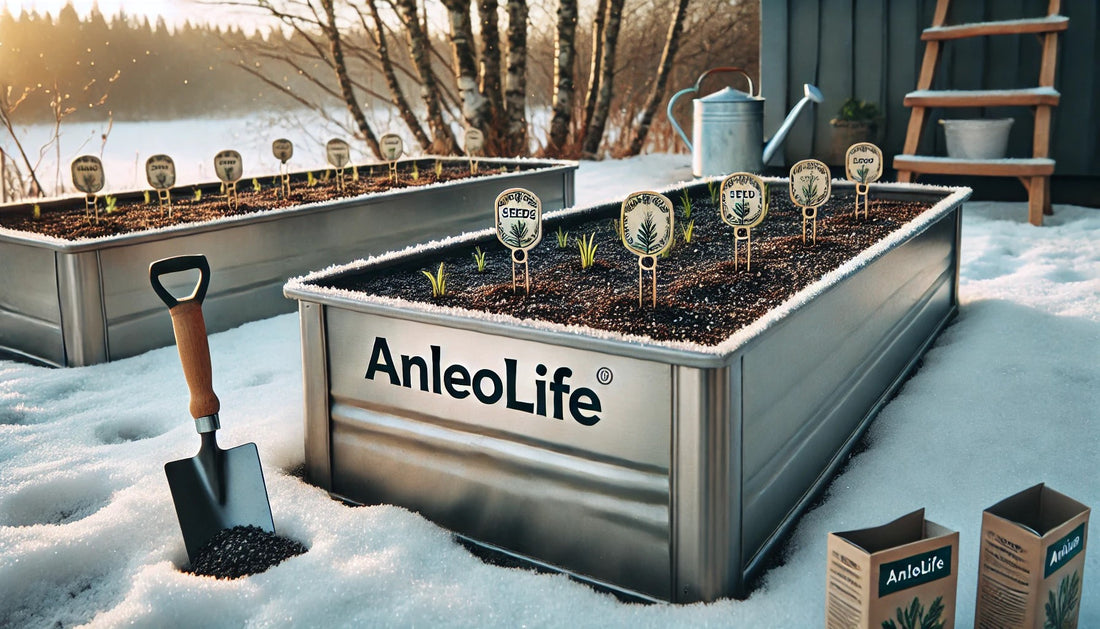Winter sowing might sound like something only expert gardeners do, but it’s actually a pretty simple trick to get a jump on your garden. Basically, it’s all about planting seeds outside during the colder months and letting nature take care of the rest. For raised bed gardeners, it’s a great way to kickstart your season with strong, hardy plants that are ready to grow when the warm weather hits. We’ll show you how to get started and what seeds to plant, so you can make the most of the winter chill.
What Is Winter Sowing
Winter sowing is a gardening technique that involves planting seeds outdoors during the colder months, allowing them to undergo natural cold stratification. This process breaks seed dormancy, leading to robust seedlings that are well-adapted to their environment. For gardeners utilizing raised beds, winter sowing can be an effective method to jump-start the growing season.
When to Start Winter Sowing for Your Raised Beds
Generally, it's best to start after the first hard frost, when temperatures consistently remain low. This timing ensures that seeds remain dormant until conditions are favorable for germination. In regions with mild winters, you might start in late December or January, while colder areas may require waiting until February.
Best Flower Seeds for Winter Sowing in Raised Beds
Certain flower seeds are particularly well-suited for winter sowing because of their hardiness and natural cold stratification requirements:
- Black-Eyed Susan (Rudbeckia hirta): A resilient perennial that thrives in various conditions and adds vibrant yellow blooms to the garden.
- Coneflower (Echinacea purpurea): Known for its drought tolerance and attractiveness to pollinators, this perennial offers striking purple flowers.
- Gaillardia (Gaillardia pulchella): Also known as blanket flower, it produces bright, daisy-like blooms and is adaptable to different soils.
- Lupine (Lupinus spp.): With its tall, colorful flower spikes, lupine enhances garden aesthetics and fixes nitrogen in the soil.
-
Columbine (Aquilegia spp.): This delicate perennial features unique, bell-shaped flowers and grows well in partial shade.

Best Vegetable Seeds for Winter Sowing in Raised Beds
Several cold-hardy vegetables are ideal candidates for winter sowing, allowing for an earlier and more productive harvest:
- Spinach (Spinacia oleracea): Prefers cooler temperatures and can be sown as soon as the soil is workable. Winter sowing results in robust plants with sweet leaves.
- Kale (Brassica oleracea var. sabellica): Extremely frost-tolerant, kale can be sown in late winter for a nutritious early crop.
- Carrots (Daucus carota): Early sowing allows carrots to mature before the heat of summer, resulting in sweeter roots.
- Radishes (Raphanus sativus): Fast-growing and cold-hardy, radishes are perfect for winter sowing and provide quick harvests.
- Peas (Pisum sativum): Thrive in cool weather and benefit from early sowing, leading to an abundant early summer harvest.
How to Prepare Raised Beds for Winter Sowing
- Begin by clearing any weeds and removing dead plants to prevent disease and pest issues.
- Amend the soil with compost to enhance fertility and structure.
- Adding a layer of mulch, such as straw or shredded leaves, can help regulate soil temperature and moisture levels.
-
Incorporating cover crops like winter rye or clover can also enrich the soil and prevent erosion.

Steps for Winter Sowing in Raised Beds
- Choose cold-hardy varieties that require or tolerate cold stratification.
- Use recycled containers, such as milk jugs, to create mini-greenhouses. Ensure they have drainage holes and can be securely closed.
- Fill containers with moist potting mix, sow seeds according to their depth requirements, and label each container.
- Position the containers in a location that receives sunlight but is protected from strong winds. The seeds will remain dormant until conditions are suitable for germination.
- As temperatures rise, check for germination and ensure the soil remains moist. Once seedlings are robust and the danger of frost has passed, transplant them into the raised garden beds.
The Bottom Line
Winter sowing is an easy, low-maintenance way to get a head start on your garden. It saves you time in spring and gives your plants a solid start. Whether you're growing veggies or flowers, this method can help you grow healthier, hardier plants. No need to wait for spring—get those seeds in the ground now, and watch your garden thrive when the warmer days arrive!
FAQs
Can I use any type of soil for winter sowing in raised beds?
For winter sowing, use a high-quality potting mix or garden soil enriched with compost. This ensures good drainage, aeration, and adequate nutrients for seed germination. Avoid heavy, compacted soil that may hinder root growth or retain excessive water, leading to seed rot.
How do I protect seeds sown directly in raised beds during winter?
Cover the beds with a protective layer such as frost cloth, plastic sheeting, or row covers. These materials help insulate the soil and seeds, shielding them from harsh winds and fluctuating temperatures. Mulching with straw or shredded leaves also offers added protection.
What if seeds germinate too early during an unexpected warm spell?
If seeds germinate early, monitor them closely and keep protective covers like cloches or row covers on hand to shield young seedlings from frost. Gradually expose seedlings to outdoor conditions to harden them off and prevent cold damage.
How do I know if winter sowing has failed?
Check for signs of poor drainage, such as water pooling in containers or beds. Seeds may fail to germinate due to oversaturation, poor soil quality, or a lack of sufficient cold stratification. If no seedlings appear after the expected germination period, inspect the seeds for rot or damage and consider reseeding.
Can I winter sow perennials and annuals together?
Yes, but ensure you group seeds with similar germination and growing requirements. For instance, plant hardy perennials and cold-tolerant annuals separately to simplify transplanting and care once they germinate.
Do I need to water seeds sown outdoors in winter?
In most cases, natural precipitation provides enough moisture for seeds sown outdoors. However, during extended dry periods or if you live in a region with minimal winter precipitation, check soil moisture periodically and water lightly to keep it damp, not soaked.
Can I use raised beds that are already planted with perennials for winter sowing?
Yes, you can sow seeds in open spaces between perennials in elevated raised beds. Ensure adequate spacing to avoid overcrowding when seedlings emerge. Be cautious not to disturb the roots of established plants.
How do I prevent pests and diseases in winter-sown raised beds?
To minimize pest and disease risks, clean the beds thoroughly before sowing. Remove any plant debris or weeds that might harbor pests or pathogens. Use mulch and covers to create a physical barrier against pests such as rodents and insects.

